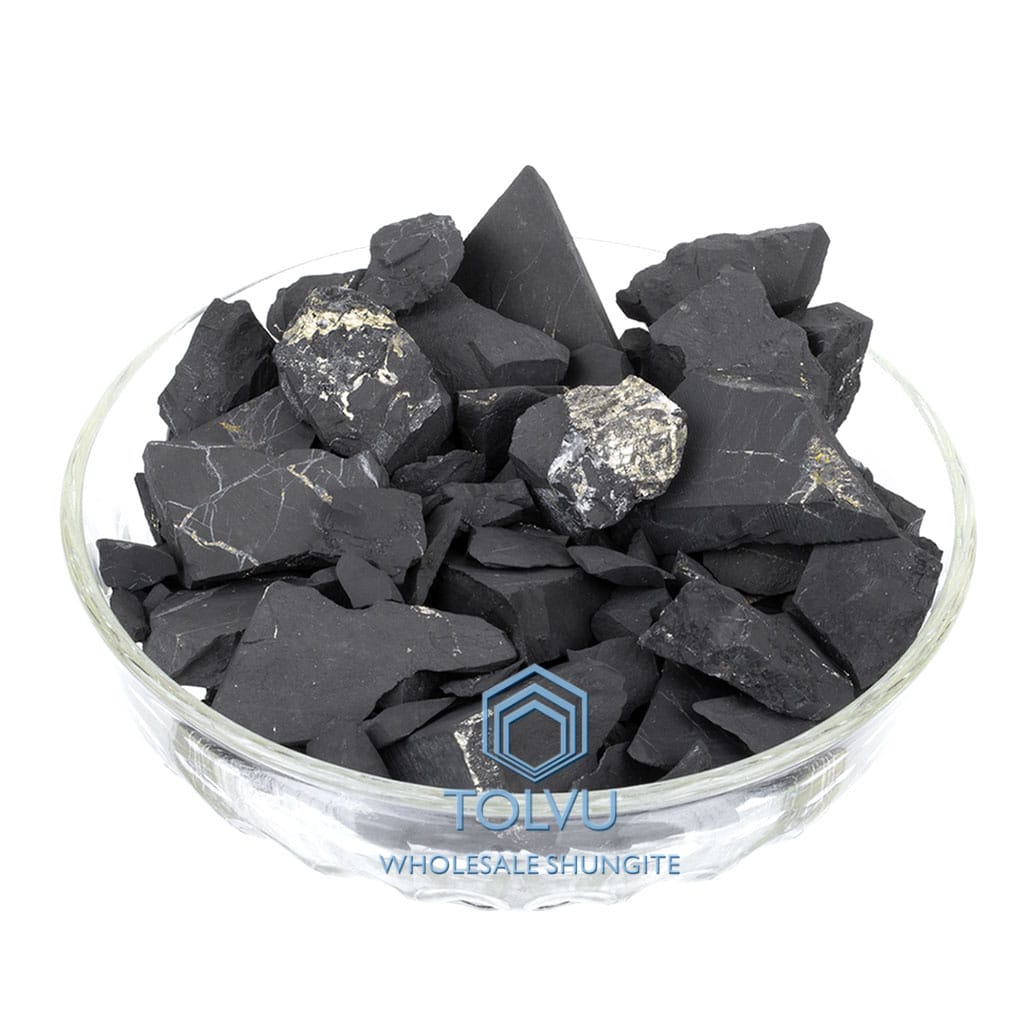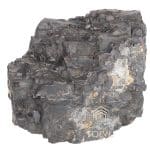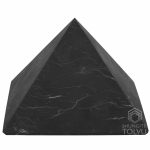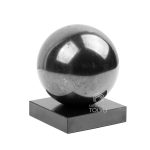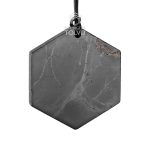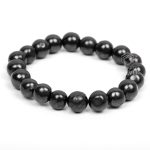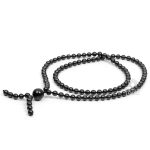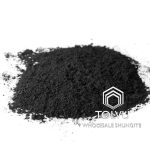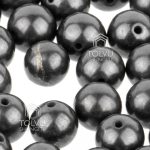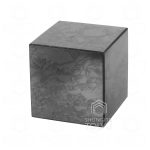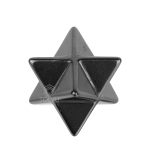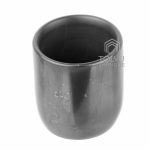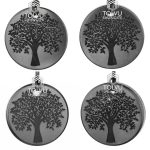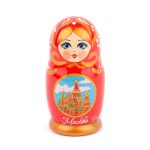About Shungite
Shungite

Shungite is one of the rarest and oldest natural rocks on Earth, and it has always stood apart from anything else.
Its most noticeable feature is its unusual carbon structure and the presence of fullerenes in the material.
There is only one known deposit of shungite in the world. It is located in the Republic of Karelia in north-western Russia, near the border with Finland. This region is full of different rocks, endless forests, and clean freshwater lakes.
Shungite exists in three natural types. They differ in carbon content and also in color. We describe all three types later in this article, so you can understand them better.
This remarkable Russian stone has a set of properties you do not usually see in ordinary rocks.
For example, all types of shungite can conduct electricity almost like a metal. Many people also use it to help soften high-frequency electromagnetic waves and unwanted energy.
In its raw form, black shungite type 3 can absorb impurities from water and shows natural antibacterial behavior. These effects have been tested and documented in scientific studies around the world.
This type of shungite is commonly used to make decorative items, souvenirs, and jewelry. You can find a full range of such products on our website.
People who see shungite for the first time often say that it feels different from any other mineral.
You can actually feel its presence, whether you keep it in your home or wear it as a pendant or a personal talisman.
Shungite has been attracting the attention of geologists, collectors, physicists, researchers, and many others for decades. Anyone who is interested in rare and authentic natural minerals usually discovers shungite sooner or later.
Many people keep shungite stones or shungite items in their home or at work because it helps create a feeling of balance and comfort. They appreciate the way this ancient material interacts with its surroundings.
The combination of rarity, beauty, scientific value, and natural protective qualities has made shungite a mineral that feels both ancient and surprisingly relevant today.
Some people value it for its EMF-related properties. Others appreciate its ability to purify water or its grounding and stabilizing energy.
In any case, shungite remains a unique stone. It is a rare gift of nature with qualities you can feel.
Shungite is more than two billion years old.
Why not four and a half billion, like the Earth? Because it formed separately as the result of complex biochemical processes, high temperature, and pressure.
Later in this article, we look deeper into each of these aspects. This will help you understand this ancient rock more fully.
Shungite properties:
- it shows strong antioxidant activity and may support the body’s natural defense processes
- it works as a sorbent that can help remove certain organic and inorganic impurities from water
- raw shungite can act as a natural catalyst, helping break down substances it has absorbed
- it contains a wide range of trace elements that take part in biological processes in living organisms
- shungite interacts with different types of electromagnetic fields (EMF, Wi-Fi) and may help reduce their influence
By the beginning of the twenty-first century, industrial shungite reserves were confirmed only in Karelia. Today, shungite is considered a purely Karelian mineral. Because its natural resources are limited and tied to one specific region, it is important to treat this unique material with care and to use it in areas where its properties are most valuable, especially in applications connected to human well-being.
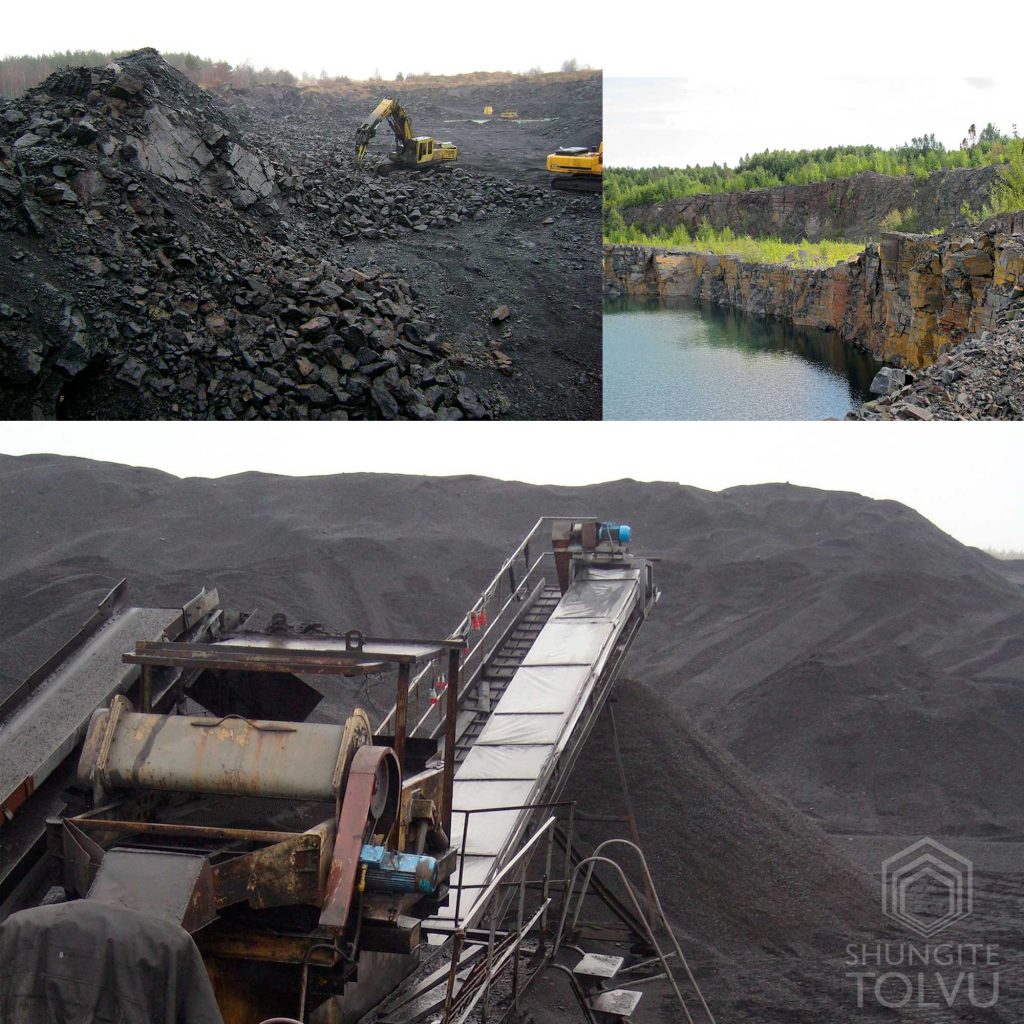
Three Types of Shungite
- Shungite 1 type (elite shungite)
- Shungite 2 type (Petrovsky shungite)
- Shungite 3 type (black color shungite, regular, classic shungite)
Shungite stone is divided into three types. Each type of shungite differs in color and chemical composition. The rarest and most valuable shungite has a silver color and contains about 98% carbon. This is the first type of shungite (descriptive adjectives like Elite or Noble are used in colloquial speech)
The second type is gray shungite, which has a matte surface and does not shine like elite. Colloquially, it has a name – Petrovsky shungite. The carbon content is about 60%.
And finally the third type is black shungite. Colloquially also known as – regular, classic shungite. The carbon content is about 30%. Yes, it is much lower than the two previous types. But it was black shungite that became the object of worldwide scientific research during which its ability to absorb EMF and purify water was discovered.
We are located and manufacture our products in Petrozavodsk, Republic of Karelia, Russia. This is the only deposit of shungite stone. We made a private chemical analysis of each type of shungite. For your convenience, we have digitized the results of these analyses and fixed them in tables. You can get acquainted with the originals of these studies on our Shungite Tolvu page.
Regular shungite chemical formula
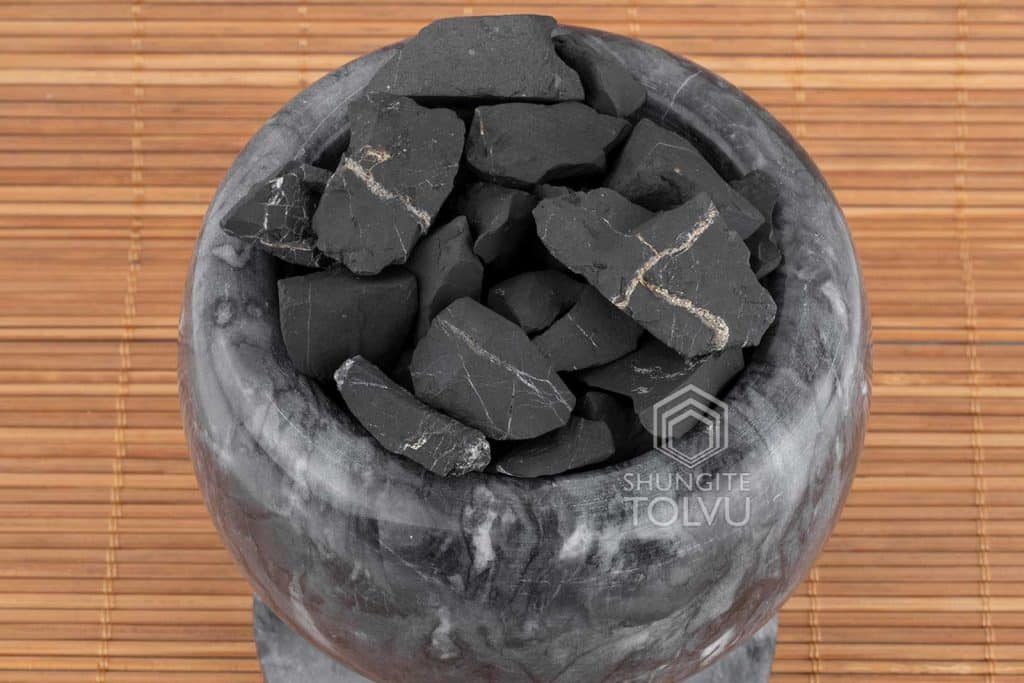
Table of the mass fraction of chemical elements in the composition of shungite stones from the Zazhoginskoe deposit. The determination of the mass fraction of elements in the samples was carried out using X-ray fluorescence analysis (XRF) ARL ADVANT’X (Thermo Scientific, Switzerland).
Element – chemical element.
m/m% – mass fraction of chemical elements in the composition of shungite stones from the Zazhoginskoe deposit.
StdErr% – error percentage
Compound – these are the oxides corresponding to the investigated elements.
To detect carbon, the so-called loss on calcination as a percentage is used. This means how much of the substance, in percentage, has left the sample in a muffle furnace at 1000 degrees Celsius. And in this case, such a substance is unique carbon. That is, this indicator shows the amount of unique shungite carbon.
| Compound | m/m% | StdErr% | Element | m/m% | StdErr% |
|---|---|---|---|---|---|
| C | 32,21 | ||||
| SiO2 | 55,90000 | 0,25000 | Si | 26,14000 | 0,12000 |
| Al2O3 | 4,52000 | 0,10000 | Al | 2,39000 | 0,05000 |
| Fe2O3 | 2,23000 | 0,07000 | Fe | 1,56000 | 0,05000 |
| K2O | 1,77000 | 0,07000 | K | 1,47000 | 0,05000 |
| SO3 | 1,36000 | 0,06000 | S | 0,54600 | 0,02300 |
| MgO | 1,21000 | 0,05000 | Mg | 0,73100 | 0,03300 |
| TiO2 | 0,31500 | 0,01600 | Ti | 0,18900 | 0,00900 |
| CaO | 0,15000 | 0,00700 | Ca | 0,10700 | 0,00500 |
| BaO | 0,10200 | 0,01100 | Ba | 0,09100 | 0,01000 |
| P2O5 | 0,04460 | 0,00380 | P | 0,01950 | 0,00170 |
| NiO | 0,03710 | 0,00190 | Ni | 0,02920 | 0,00150 |
| ZnO | 0,03350 | 0,00170 | Zn | 0,02690 | 0,00130 |
| V2O5 | 0,03290 | 0,00160 | V | 0,01840 | 0,00090 |
| Cr2O3 | 0,01300 | 0,00060 | Cr | 0,00890 | 0,00040 |
| As2O3 | 0,01220 | 0,00170 | As | 0,00920 | 0,00130 |
| CuO | 0,01190 | 0,00060 | Cu | 0,00950 | 0,00050 |
| MnO | 0,01090 | 0,00050 | Mn | 0,00840 | 0,00040 |
| ZrO2 | 0,01040 | 0,00060 | Zr | 0,00770 | 0,00050 |
| PbO | 0,00540 | 0,00080 | Pb | 0,00500 | 0,00070 |
| Rb2O | 0,00420 | 0,00040 | Rb | 0,00380 | 0,00030 |
| Rh2O3 | 0,00270 | 0,00090 | Rh | 0,00220 | 0,00080 |
| SeO2 | 0,00260 | 0,00030 | Se | 0,00190 | 0,00020 |
| Y2O3 | 0,00190 | 0,00050 | Y | 0,00150 | 0,00040 |
| Ga2O3 | 0,00160 | 0,00020 | Ga | 0,00120 | 0,00020 |
| CO3O4 | 0,00140 | 0,00040 | Co | 0,00100 | 0,00030 |
| La2O3 | 0,00140 | 0,00050 | La | 0,00120 | 0,00050 |
| Nb2O5 | 0,00140 | 0,00070 | Nb | 0,00098 | 0,00051 |
| Sc2O3 | 0,00130 | 0,00020 | Sc | 0,00085 | 0,00015 |
| SrO | 0,00086 | 0,00040 | Sr | 0,00073 | 0,00036 |
Petrovskiy shungite chemical formula
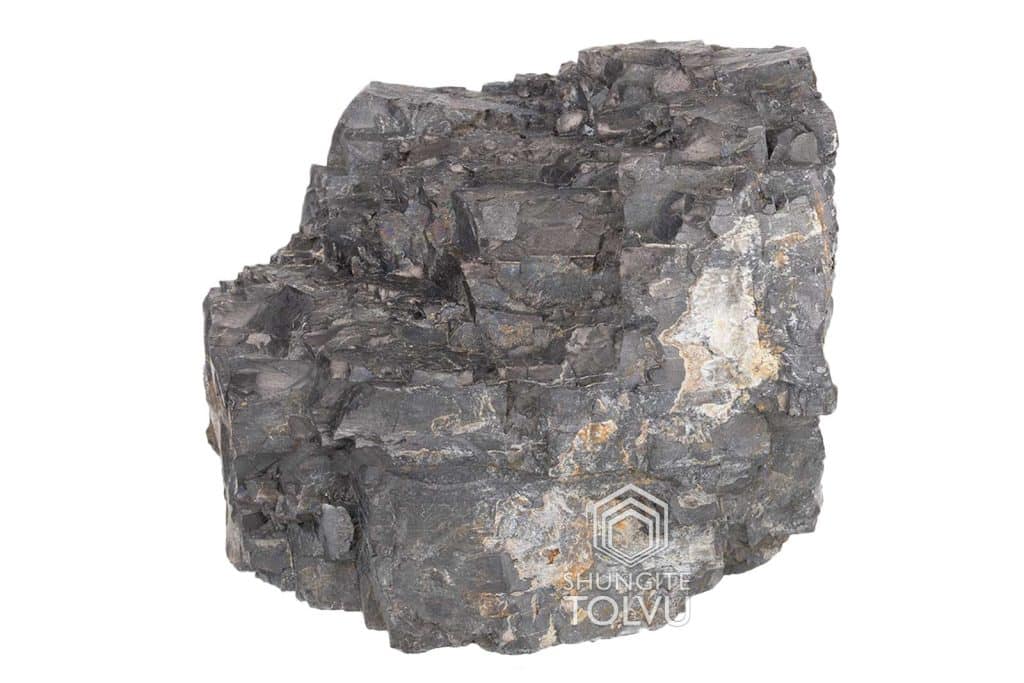
Table of the mass fraction of chemical elements in the composition of shungite stone (shungite type 2) from the Shun’ga deposit. The determination of the mass fraction of elements in the samples was carried out using X-ray fluorescence analysis (XRF) ARL ADVANT’X (Thermo Scientific, Switzerland).
Element – chemical element.
m/m% – mass fraction of chemical elements in the composition of shungite stone (shungite type 2) from the Shun’ga deposit.
StdErr% – error percentage
Compound – these are the oxides corresponding to the investigated elements.
To detect carbon, the so-called loss on calcination as a percentage is used. This means how much of the substance, in percentage, has left the sample in a muffle furnace at 1000 degrees Celsius. And in this case, such a substance is unique carbon. That is, this indicator shows the amount of unique shungite carbon.
| Compound | m/m% | StdErr% | Element | m/m% | StdErr% |
|---|---|---|---|---|---|
| C | 65,93000 | ||||
| SiO2 | 16,36000 | 0,18000 | Si | 7,65000 | 0,09000 |
| Fe2O3 | 6,41000 | 0,12000 | Fe | 4,48000 | 0,09000 |
| SO3 | 4,61000 | 0,10000 | S | 1,84000 | 0,04000 |
| Al2O3 | 2,67000 | 0,08000 | Al | 1,42000 | 0,04000 |
| K2O | 1,37000 | 0,06000 | K | 1,14000 | 0,05000 |
| MgO | 1,13000 | 0,05000 | Mg | 0,68000 | 0,03200 |
| Na2O | 0,55600 | 0,02800 | Na | 0,41300 | 0,02100 |
| V2O5 | 0,23500 | 0,01200 | V | 0,13100 | 0,00700 |
| TiO2 | 0,21900 | 0,01100 | Ti | 0,13100 | 0,00700 |
| CaO | 0,14200 | 0,00700 | Ca | 0,10100 | 0,00500 |
| BaO | 0,08700 | 0,01300 | Ba | 0,07800 | 0,01100 |
| As2O3 | 0,05000 | 0,00250 | As | 0,03790 | 0,00190 |
| MoO3 | 0,04800 | 0,00240 | Mo | 0,03200 | 0,00160 |
| NiO | 0,04490 | 0,00220 | Ni | 0,03530 | 0,00180 |
| ZnO | 0,02950 | 0,00150 | Zn | 0,02370 | 0,00120 |
| P2O5 | 0,02380 | 0,00120 | P | 0,01040 | 0,00050 |
| CuO | 0,01740 | 0,00090 | Cu | 0,01390 | 0,00070 |
| Cr2O3 | 0,01380 | 0,00070 | Cr | 0,00940 | 0,00050 |
| ZrO2 | 0,01150 | 0,00070 | Zr | 0,00850 | 0,00050 |
| Co3O4 | 0,00700 | 0,00060 | Co | 0,00510 | 0,00050 |
| U3O8 | 0,00640 | 0,00110 | U | 0,00540 | 0,00090 |
| PbO | 0,00570 | 0,00080 | Pb | 0,00530 | 0,00080 |
| Y2O3 | 0,00570 | 0,00050 | Y | 0,00450 | 0,00040 |
| MnO | 0,00340 | 0,00030 | Mn | 0,00260 | 0,00020 |
| Nb2O5 | 0,00230 | 0,00070 | Nb | 0,00160 | 0,00050 |
| Rb2O | 0,00210 | 0,00040 | Rb | 0,00190 | 0,00040 |
| SeO2 | 0,00150 | 0,00030 | Se | 0,00110 | 0,00020 |
| SrO | 0,00130 | 0,00040 | Sr | 0,00110 | 0,00040 |
| La2O3 | 0,00120 | 0,00040 | La | 0,00100 | 0,00030 |
Elite shungite chemical formula
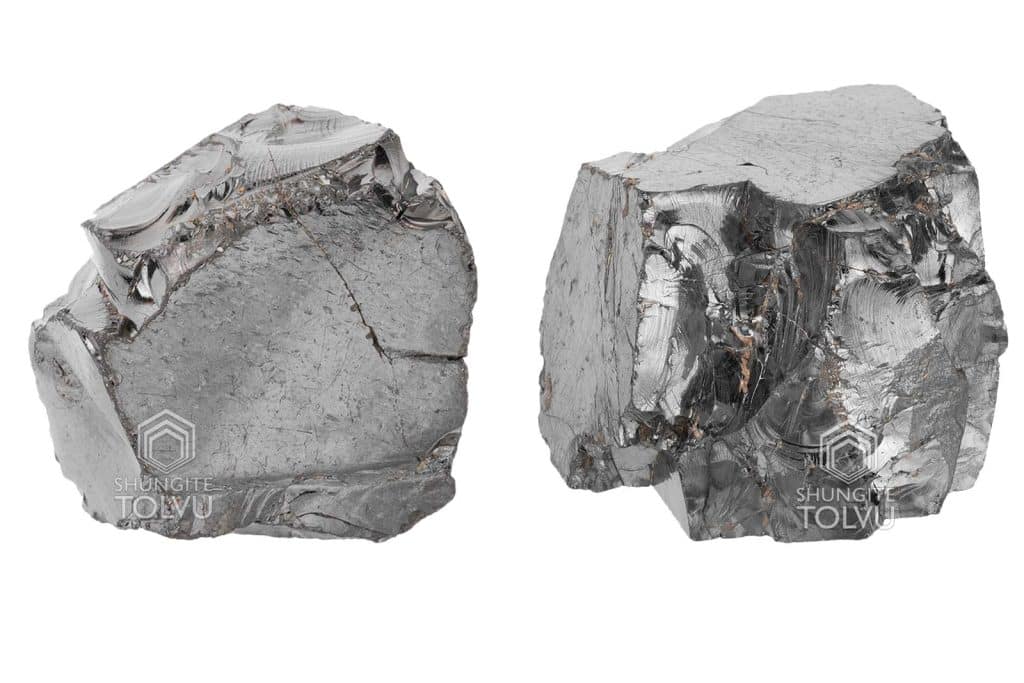
Table of the mass fraction of chemical elements in the composition of shungite stone of 1 type (elite shungite) from the Shun’ga deposit. The determination of the mass fraction of elements in the samples was carried out using X-ray fluorescence analysis (XRF) ARL ADVANT’X (Thermo Scientific, Switzerland).
Element – chemical element.
m/m% – mass fraction of chemical elements in the composition of shungite stone (elite shungite) from the Shun’ga deposit.
StdErr% – error percentage
Compound – these are the oxides corresponding to the investigated elements.
To detect carbon, the so-called loss on calcination as a percentage is used. This means how much of the substance, in percentage, has left the sample in a muffle furnace at 1000 degrees Celsius. And in this case, such a substance is unique carbon. That is, this indicator shows the amount of unique shungite carbon.
| Compound | m/m% | StdErr% | Element | m/m% | StdErr% |
|---|---|---|---|---|---|
| С | 98,30000 | ||||
| SiO2 | 0,41600 | 0,02100 | Si | 0,19500 | 0,01000 |
| S | 0,19900 | 0,01000 | S | 1,19900 | 0,01000 |
| Fe2O3 | 0,19400 | 0,01000 | Fe | 0,13500 | 0,00700 |
| Na2O | 0,18500 | 0,00900 | Na | 0,13800 | 0,00700 |
| MgO | 0,16500 | 0,00800 | Mg | 0,09930 | 0,00490 |
| V2O5 | 0,11500 | 0,00600 | V | 0,06430 | 0,00320 |
| Al2O3 | 0,09550 | 0,00470 | Al | 0,05050 | 0,00250 |
| NiO | 0,07380 | 0,00370 | Ni | 0,05800 | 0,00290 |
| BaO | 0,05870 | 0,00990 | Ba | 0,05260 | 0,00890 |
| K2O | 0,04860 | 0,00240 | K | 0,04030 | 0,00200 |
| CaO | 0,04050 | 0,00200 | Ca | 0,02900 | 0,00140 |
| MoO3 | 0,03170 | 0,00160 | Mo | 0,02110 | 0,00110 |
| ZnO | 0,01800 | 0,00090 | Zn | 0,01450 | 0,00070 |
| P2O5 | 0,01110 | 0,00060 | P | 0,00480 | 0,00020 |
| TeO2 | 0,00980 | 0,00410 | Te | 0,00780 | 0,00320 |
| As2O3 | 0,00850 | 0,00130 | As | 0,00640 | 0,00090 |
| ThO2 | 0,00810 | 0,00200 | Th | 0,00710 | 0,00180 |
| TiO2 | 0,00610 | 0,00030 | Ti | 0,00370 | 0,00020 |
| Nb2O5 | 0,00350 | 0,00060 | Nb | 0,00240 | 0,00040 |
| Cr2O3 | 0,00270 | 0,00030 | Cr | 0,00180 | 0,00020 |
| CuO | 0,00270 | 0,00010 | Cu | 0,00220 | 0,00010 |
| Co3O4 | 0,00200 | 0,00010 | Co | 0,00150 | 0,00010 |
| ZrO2 | 0,00170 | 0,00060 | Zr | 0,00130 | 0,00040 |
| MnO | 0,00160 | 0,00010 | Mn | 0,00120 | 0,00010 |
| SeO2 | 0,00071 | 0,00024 | Se | 0,00051 | 0,00017 |
| Tb4O7 | 0,00044 | 0,00022 | Tb | 0,00037 | 0,00019 |
| Ga2O3 | 0,00035 | 0,00013 | Ga | 0,00026 | 0,00010 |
General information about shungite
What is Shungite stone?
Shungite is an ancient carbonaceous rock with an age of about 2 billion years. Shungite carbon is a solid residue of the oldest oil, and shungite from the zazhoginsky field is a fossilized organo-silicate (siloxane) gel.
When did this black stone become known?
The rock got its name – “Shungite” 130 years ago, but until recently it was not used, i.e. it was not a mineral. Shungit begins to actively enter the economic life only in the XXI century.
Early use of shungite
Shungite was not used in practice because of its unusual properties. An example of this is the history of using shungite as an energy fuel. Shungite did not burn in the furnaces. It did not burn, because shungite carbon has a high activity and reactivity. So high that when heated, it does not need to take oxygen from the air. Shungite stone takes oxygen from its nearest neighbors – silicate minerals, showing “antioxidant” properties in thermal processes. Unusual properties reported shungite carbon shungite rocks and unusual special (shungit) carbon structure.
The Structure Of Shungite
The shungite structure is defined as non-crystalline, metastable, non-graphitizable, globular, and fullerene-like. The main element of this structure is a globule with dimensions of 100-300 A0 (10-30 nanometers). The globule has a bulbous structure and the ability to change the order within fullerene-like layers and the distance between layers within small limits. This is reflected in the definition of “metastability of the structure” of shungite carbon. The structure of the globules themselves is stable against phase transitions of shungite carbon to other types of crystalline carbon – graphite and diamond.
How much carbon is in Shungite?
Shungite stone of the zazhoginsky Deposit consisting of 30% shungite carbon and 56 % silicates is a nanostructured natural composite. Elite shungite contatins about 98% of carbon. The nanostructure of such a rock determines its specific properties: sorption, catalytic, reducing (antioxidant), and the ability to self-regenerate.
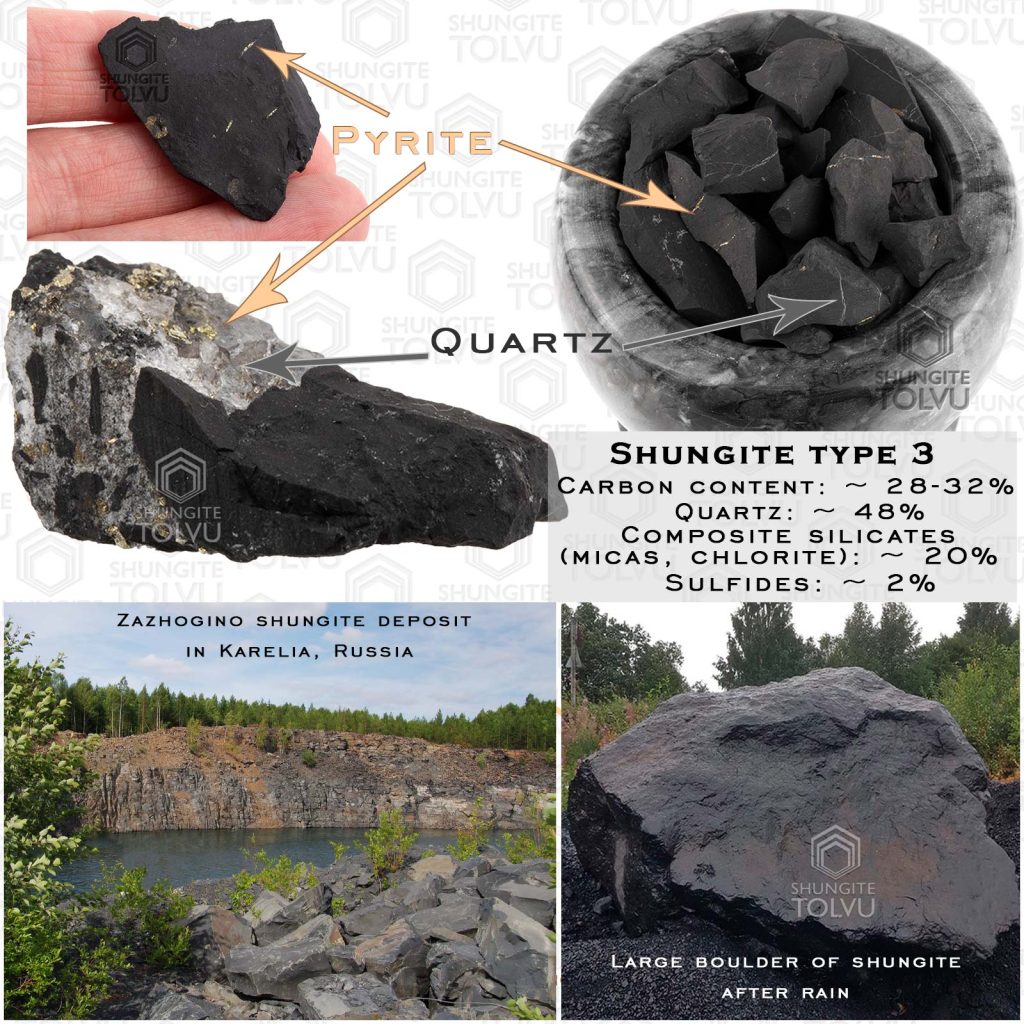
Do shungite products have “scratches”?
Due to the fact that genuine shungite stone contains minerals such as quartz and pyrite, this is reflected in the appearance of the product. Therefore, on the black surface of our natural stone products there will always be some intricate pattern of quartz and pyrite veins.
Thus, the patterns of quartz and pite on shungite are not scratches! And also they are not stone defects! This is the natural texture of this rare mineral.
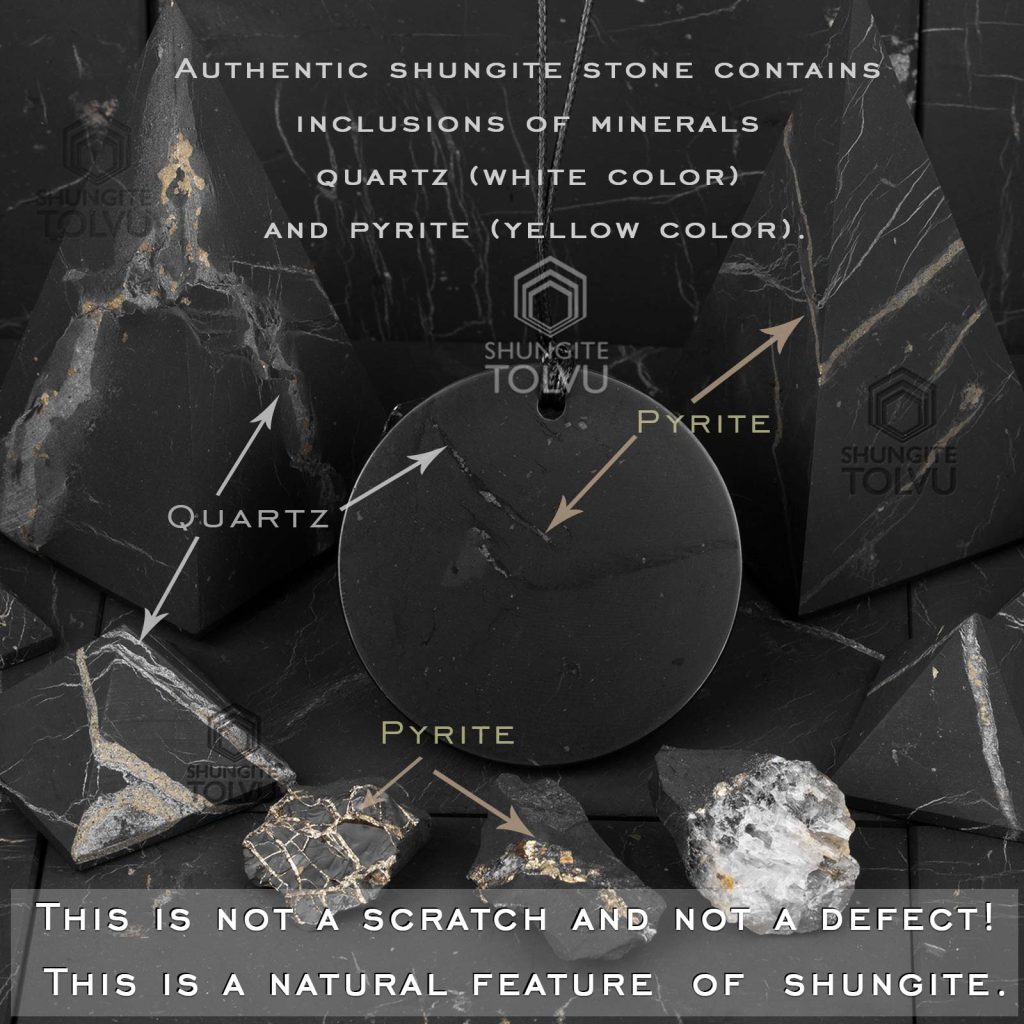
Our natural pendants are not Chinese factory stamped blanks made of black acrylic or glass, which are now abundant on the Internet market.
In each case, the pendant will have its own unique design, depending on the patterns of quartz and pyrite on them.
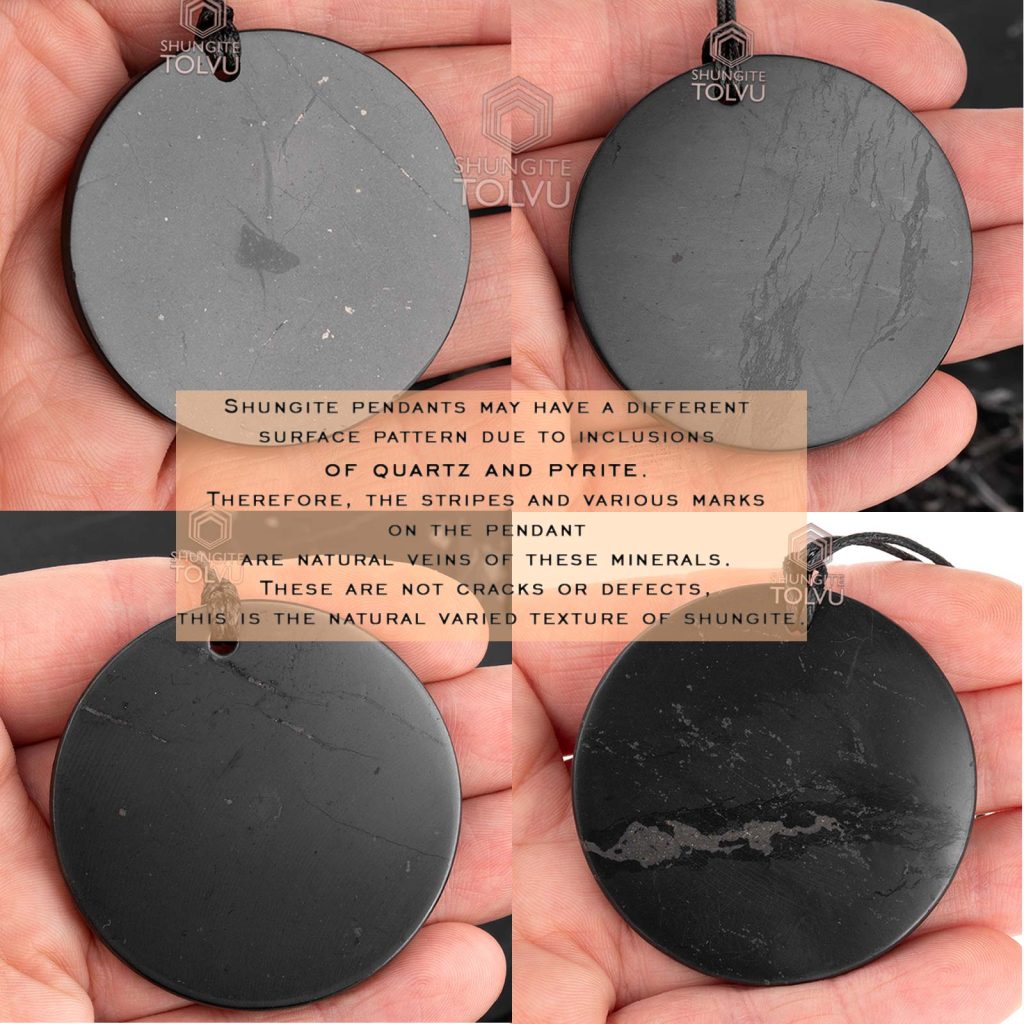
In addition, the surface of the pyramids can also have a bizarre pattern. Regardless of the degree of surface treatment: polished or unpolished, the pyramid will always be unique and amazing. Also, the surface of the pyramids can also have a bizarre pattern. Regardless of the degree of surface treatment: polished or unpolished, the pyramid will always be unique and amazing.
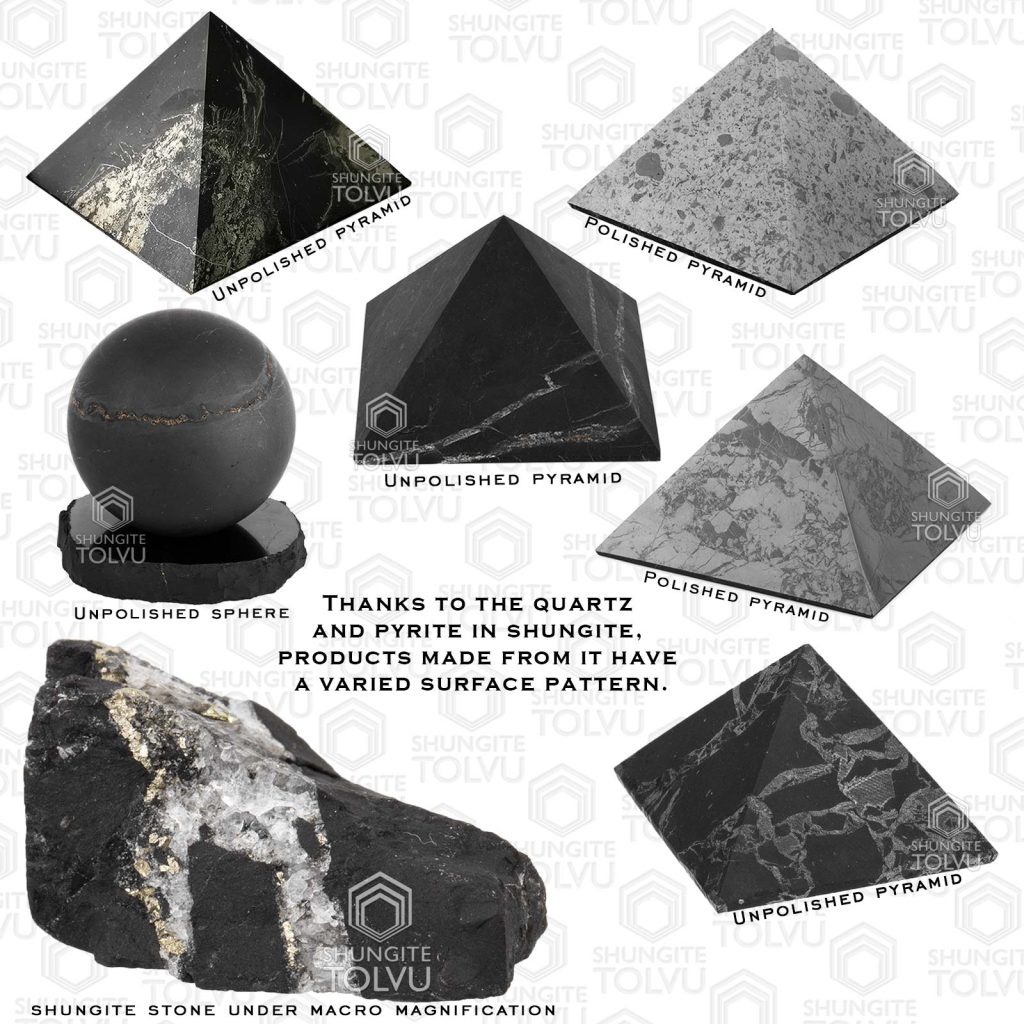
Shungite as a sorbent for water treatment
- Shungite as a sorbent is characterized by a number of positive characteristics:
- high mechanical strength and low abrasion resistance;
- high filtering capacity (processability, characterized by low pressure resistance);
- the ability to Sorb many substances, both organic (petroleum products, benzene, phenol, pesticides, etc.) and mineral (iron, manganese, phosphorus, arsenic).
Shungite stone is able to clean water from petroleum products to the MPC of water discharge into fisheries reservoirs. This effect is used in shungite filters installed on the Moscow ring road and new highways.
Shungite is a dense material with low porosity, the inner surface is significantly inferior to activated carbon.
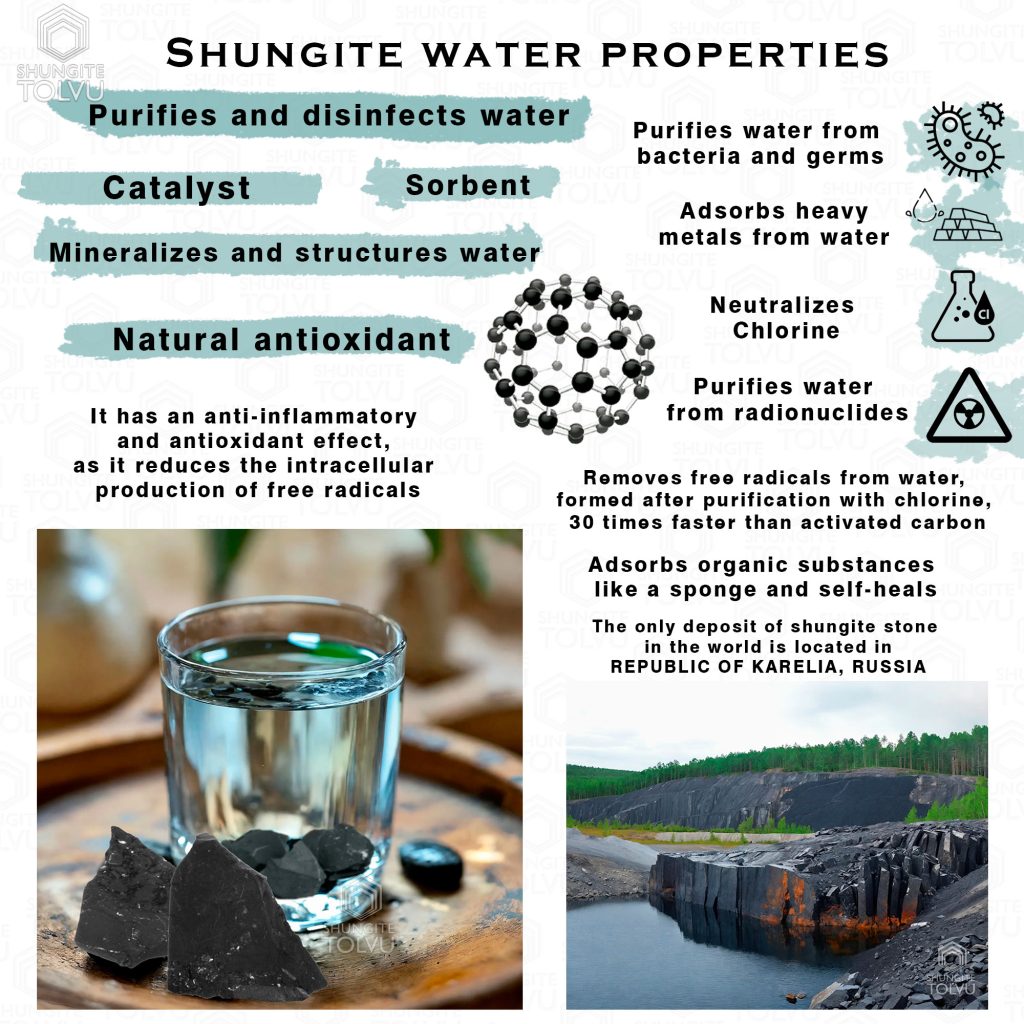
How effective is shungite stone as a sorbent, and how long can it work?
According to the work performed at VIMS and the University of Chemical technology. Mendeleev shungite sorbent loses to activated carbon at the first stage, during the first 250 hours, and then begins to purify the solution at a higher and constant rate. This is due to the catalytic properties of shungite, the ability to catalytically oxidize sorbed organic substances.
Shungite stone as a strong reducing agent
Shungite stone as a strong reducing agent absorbs oxygen from water. In the process of chemical interaction with this oxygen, atomic oxygen is formed, which is the strongest oxidizer and oxidizes the sorbed organic substances to CO2 and H2O and frees the shungite surface for new sorption acts.
The long-term effect of shungite on dissolved metals is explained by the fact that metals are converted by shungite into the form of insoluble carbonates. This is facilitated by the process of oxidation of organic substances to CO2.
The ability of shungite to absorb oxygen and actively interact with it at room temperatures in water and air has numerous practical confirmations.
Russian health resort “Marcial waters”
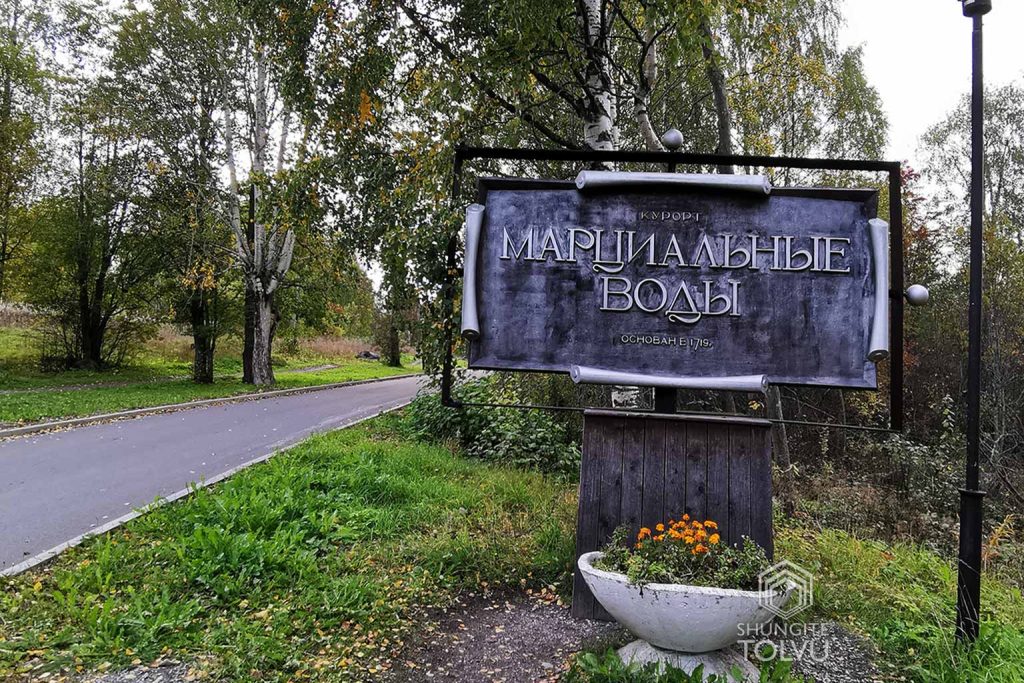
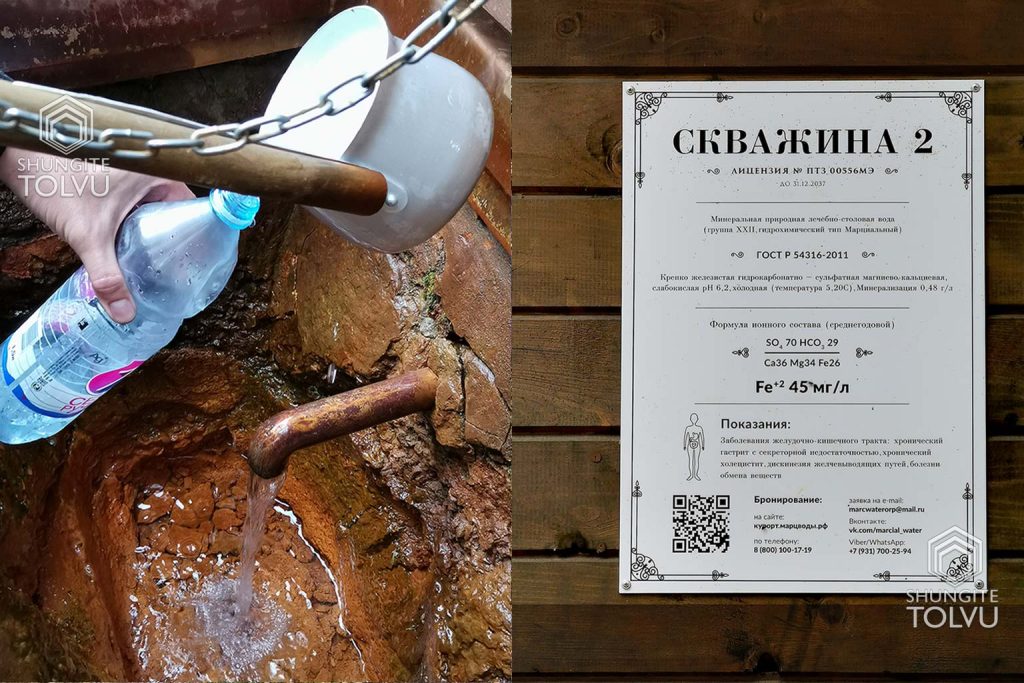
There is no oxygen in the water of the sanatorium “Marcial waters” (Republic of Karelia) coming out of the shungite strata. Due to this, the iron present in water in high concentrations is in a divalent soluble form. When exposed to the surface and in contact with air, iron is oxidized and precipitates in the form of ochre.
This phenomenon is completely simulated under artificial conditions. In a vessel with shungite and water, iron is released on the vessel wall only above the shungite stone layer. Iron does not fall directly from the water of the shungite backfill layer. It is obvious that shungite absorbs dissolved oxygen and is more active than iron.
I. O. Krylov and A.V. Krylova provide information about the decomposition of sorbed petroleum products on the surface of shungite at room temperature. The concentration of petroleum products on shungite after storage for 4 months decreased by 77.0-99.7%, depending on the initial concentration. “Self-regeneration” of shungites, apparently, was a consequence of the catalytic oxidation of petroleum products.
Anti-oxidant abilities of this black stone
High reducing, antioxidant properties of shungite stone are shown not only in relation to oxygen. Studies of the antioxidant properties of shungite in relation to organochlorine compounds and free radicals performed at Moscow University and the Military Medical Academy showed that shungite removes free radicals from water 30 times better than activated carbon and almost completely. This is an extremely important circumstance because free radicals formed during the treatment of water with chlorine have an extremely negative effect on the human body and are the cause of many serious diseases (cardiovascular, oncological, as well as diabetes, aging pathologies, atherosclerosis). Regular consumption of free-radical particles with drinking water depletes the body’s biochemical mechanisms and contributes to the development of various pathologies. One of the ways to solve the problem of antioxidant protection of the population is to search for natural antioxidants and shungite stone is an effective natural antioxidant.
Spectrum of health properties of shungite stone
First, shungite water has long been used to treat skin diseases. On the territory of the Zaonezhsky Peninsula in lake Onega there is a spring “Three Ivans”, which the local population revered as a Saint and went to be treated from other regions, despite its inaccessibility.
Artificial infusions on shungite also treat skin diseases. At the Tula research Institute “New medical technologies”, research has shown that shungite preparations accelerate cell renewal and epitalization, enrich cells with essential nutrients, stimulate blood circulation and skin cell regeneration, and relieve irritation. Shungite preparations have a bactericidal effect, relieve itching, and have an analgesic effect.
Shungite in animal husbandry
When using shungite preparations in the feed of piglets, the effect of complete recovery from diarrhea was noted. The use of shungite in the feed foxes according to the Institute of biology, Karelian research centre of RAS increased the mass of foxes, improved the quality of fur, promoted conservation pups per litter and increased livestock.
The introduction of shungite in the diet of broiler chickens revealed its ability to compensate for the negative impact of low – quality, mycotoxin-infected feed on poultry growth.
Shungite is recommended by VNIITI poultry farms in the country as a mineral Supplement for the prevention of chronic mycotoxicosis and stimulation of poultry growth.
Black stone in medicine
The noted properties of shungite open up the possibility of using it in medicine (in particular, in dermatology, dentistry, gynecology), in veterinary medicine, animal husbandry, and poultry farming.
Shungite stone conducts an electric current
Shungite of the zazhoginsky Deposit is an electrically conductive stone. This property of shungite was the basis for creating on its basis a wide class of electrically conductive building materials with radio-shielding and radio-absorbing properties.
Shungite radio shielding materials have been thoroughly tested at industrial facilities to protect electronic information and have proven to be reliable, durable, environmentally friendly and safer than metal screens.
Protection from EMF
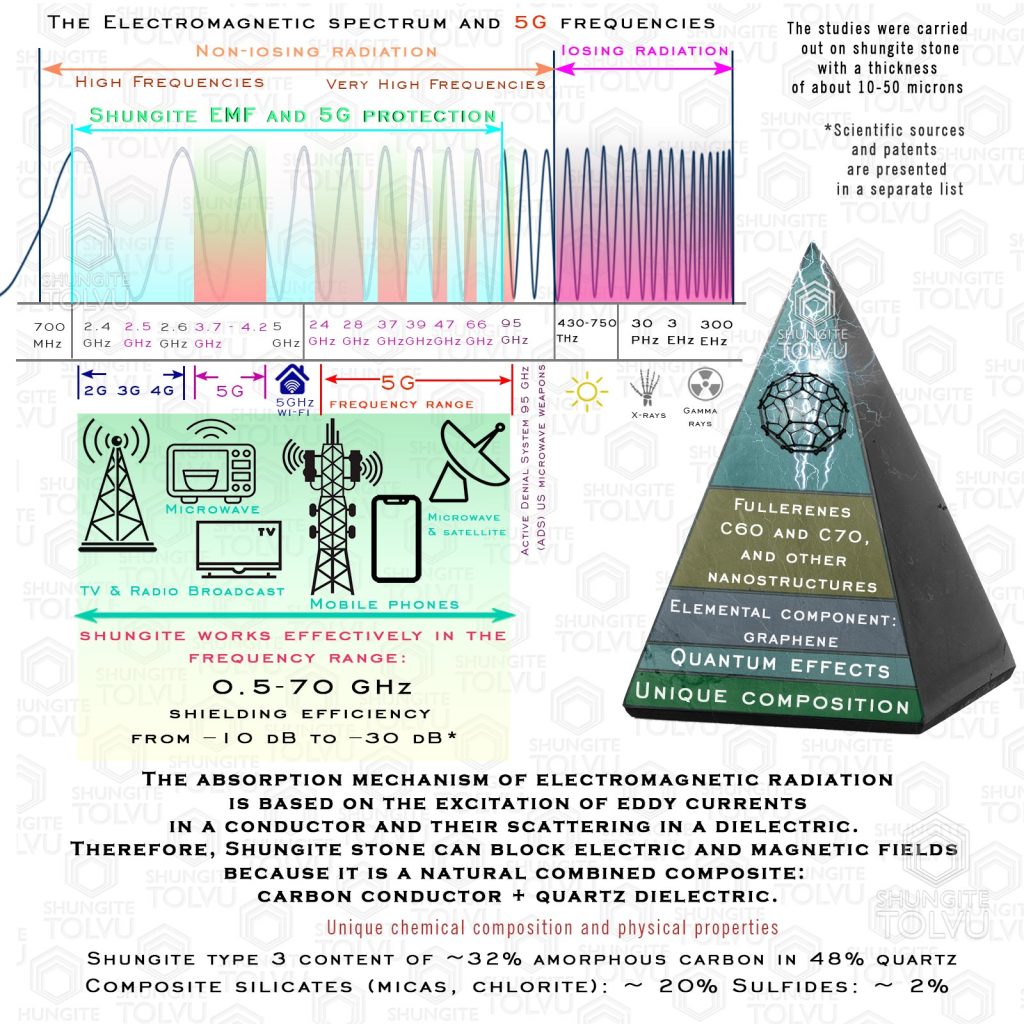
The topic of protection from electromagnetic smog is becoming more and more relevant. This leads to the introduction of electronic household appliances and communications equipment into everyday life and economic practice, as well as an understanding of the harmful effects of solar storms and geopathogenic zones on health.
Shungites capable of interacting with electromagnetic fields of various nature provide protection from the harmful effects of these radiations. Rooms shielded with shungite materials reduce the level of human exposure to artificial and natural sources hundreds of times and create conditions for a comfortable stay in them and restore health.
For example, in the wards of the Military Medical Academy (Saint Petersburg), shielded with shungite, patients recover much faster.
Scientific research in the field of EMF protection
The Tula research Institute” New medical technologies ” shows that the presence of shungite materials near the source of cellular frequency radiation significantly weakens their effect on the body.
In recent years, a number of new materials based on shungite have been developed for protection against electromagnetic radiation in premises and for individual human protection (Belarus).
Useful potential of Shungite stone
The ecological potential of shungite is very wide. It is implemented in the processes of water and air purification, protecting people from electromagnetic radiation of various nature, improving the immune characteristics of humans and animals, and in therapeutic properties in relation to a wide range of diseases.
In specific practical terms it is used in filters for drinking water preparation and wastewater treatment, in the creation of radioprotective materials and devices, medical rehabilitation centers of sagitarii, in agriculture, veterinary science, and to improve the quality of feed, production of pure natural “no chemical fertilizers”.
